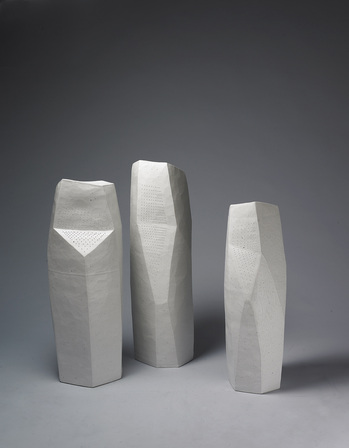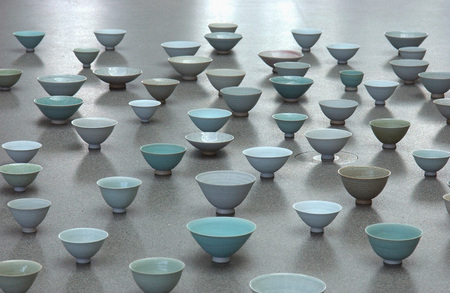UMMA showcases modern clay works from 5 Korean artists

"Crystalloid Columns" by Kim Yikyung
The exhibit ties together two strands of Korean art. On one hand, each ceramicist engages in contemporary non-traditional approaches to art; yet the tradition of clay runs so deep in Korean aesthetics, each artist is indebted to their culture’s heritage. The most interesting aspect of the exhibit, therefore, is getting the chance to see them break loose of their artistic moorings.
Korean ceramics goes back nearly 1,200 years, with high-fired stoneware being produced at an exceedingly high level during the periods of the 18 BCE-660 CE Korean Koguryo, Paekche, and Silla “Three Kingdoms” eras.
Later, as the UMMA’s exhibition statement tells us, “The celadon (jade-green glaze) of the (918-1392 CE) Goryeo Dynasty, and ‘buncheong’ porcelain wares of the Joseon period (1392-1910 CE) provide a source for inspiration of forms, colors, techniques, and designs.
“Moreover, Korean ceramics are well-known for the spontaneity of their throwing and firing processes. This often results in uneven, slightly distorted, and thus ‘imperfect’ wares that evoke a lively, natural feeling.”
Simply put, Korean ceramics is among the art world’s greatest treasures. Their unassuming simplicity of color, shape, and design—coupled with this extraordinarily subdued ‘imperfect’ expression—has created a longstanding heritage that’s still the standard contemporary ceramicists grapple with.
As the five masters (Kim Yikyung, Yoon Kwang-cho, Lee Young-Jae, Lee In Chin, and Lee Kang Hyo) of this display show us, contemporary Korean ceramics meets that challenge today.
The exhibit is divided into discrete settings for each artist. This allows them to dominate the museum's Taubman gallery with their unique artforms.
Lee Kang Hyo—a graduate of Korea’s most prestigious art school, Hong-ik University—is intent upon balancing his creativity between functional (if not also ‘irregular’) bottles, jars, and plates against a stylish series of abstracted plates.
Lee’s contributed a baker’s dozen bottle and lidded jars on a large wooden shelf in the gallery whose slight irregular form illustrates what is labeled as his “Playful” temperament. But a dozen one-foot 2009 “Sky” plates lined up against a Taubman wall are also extraordinarily sublime; each plate being a gray clay, shell thrown white slip with brushed gestural ash glaze. Each of these curvilinear masterworks reflects a placid disposition that contemplates time and space. Taken together, they reflect a durable, good-natured philosophy of life.
By contrast, Yoon Kwang-cho’s display area has been labeled “Mountain Recluse” for the pensive approach he’s taken to his work, which has been influenced by where he’s chosen to live: The Haean and Dongdae mountains.
Yoon’s triangular or quadrilateral “buncheong” work is inscribed with poetry, landscape, or vertical abstract markings. His white slip dripped and brushed glaze give his ceramics the appearance of quasi-geologic formations. Of these works, Yoon’s 2001 coarse clay covered with white slip, nail-incised “Heart Sutra” vessel best exemplifies his Buddhist aesthetic through nontraditional form. The work, shorter than two feet in height, has the rough appearance of an ancient stone block upon which a poem has been incised with a stolidly painstaking, reverential dignity.
Lee Young-Jae is described as having a “European-Korean perspective” and Lee In Chin is described as having an “American-Korean perspective.” But these are only geographic designations based upon where the artists have chosen to live. Both have contributed a near-mountain of expert clay pots and bowls.
Lee In Chin’s 2010 stoneware, unglazed wood fired installation features three stacked shelves of more than 100 jars, plates, vessels, and bowls of variable size ranging from oversized to diminutive. The colors and textures are amazing—they look like nothing less than a warehouse of superior historic functional clay—because the work reflects the different styles of different eras.

"111 Bowls" by Lee Young-Jae
Kim Yikyung’s “Courtly Elegance” is amply illustrated. Her 2009 “Bowl and Lidded Jar” porcelain set is so devoid of expression, they are the epitome of refinement. They may well be perfection in the guise of ceramics.
On the other hand, her 2009 porcelain “Crystalloid Columns (Garden Lamps)” and “Pentagon Forms (Garden Stools)” set within a nearby gallery rock garden give us a sense of her contemporary expression. And they reflect another sensibility altogether. These rectilinear works sit with a handsome stolidity that reflects their function as well as Kim’s reverence for simple geometry.
“Life in Ceramics: Five Contemporary Korean Artists” will continue through June 26 at the University of Michigan Museum of Art, 525 S. State St. Museum hours are 10 a.m. to 5 p.m., Tuesday-Saturday; and noon to 5 p.m., Sunday. For information, call 734-763-UMMA. ###

